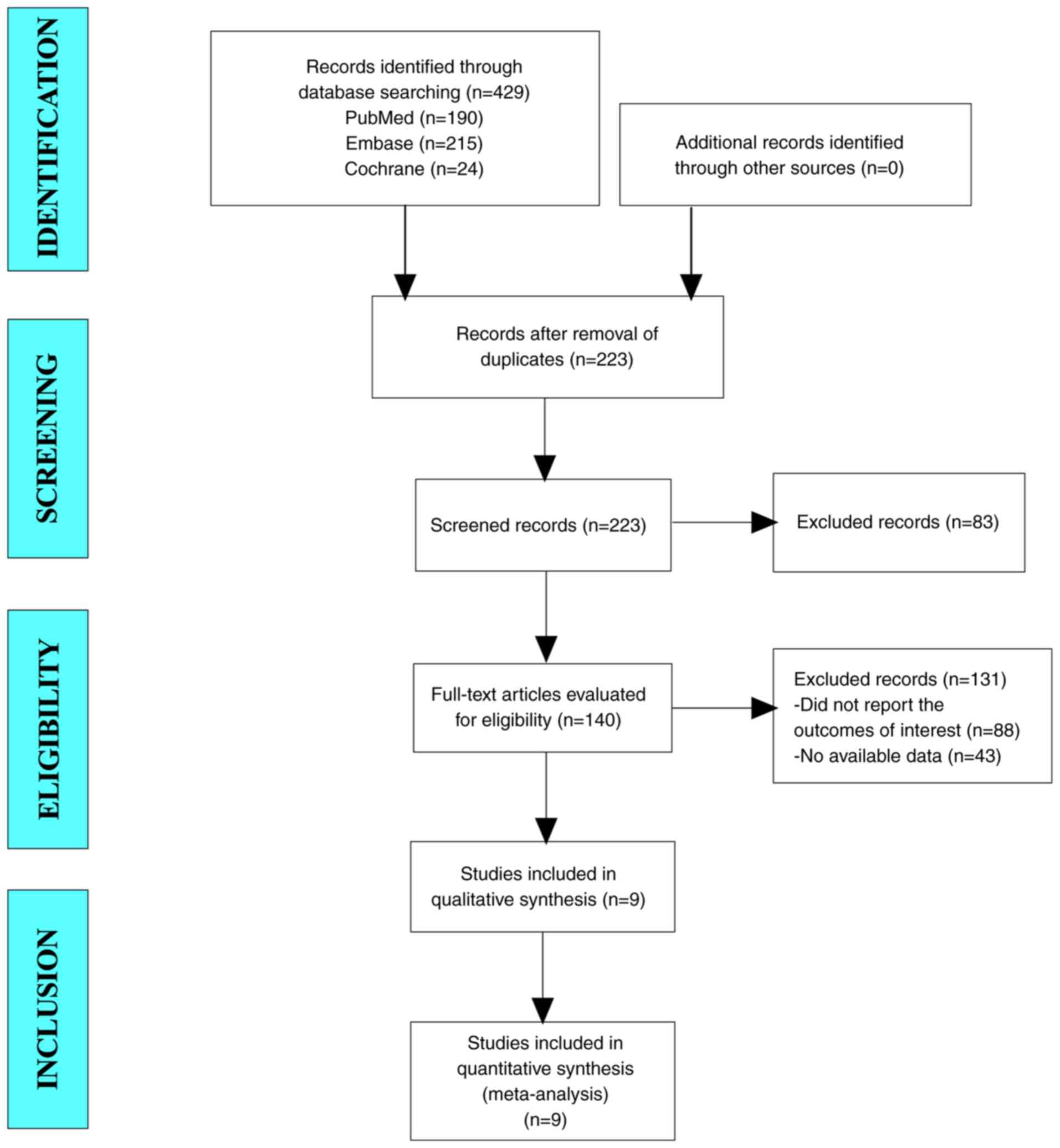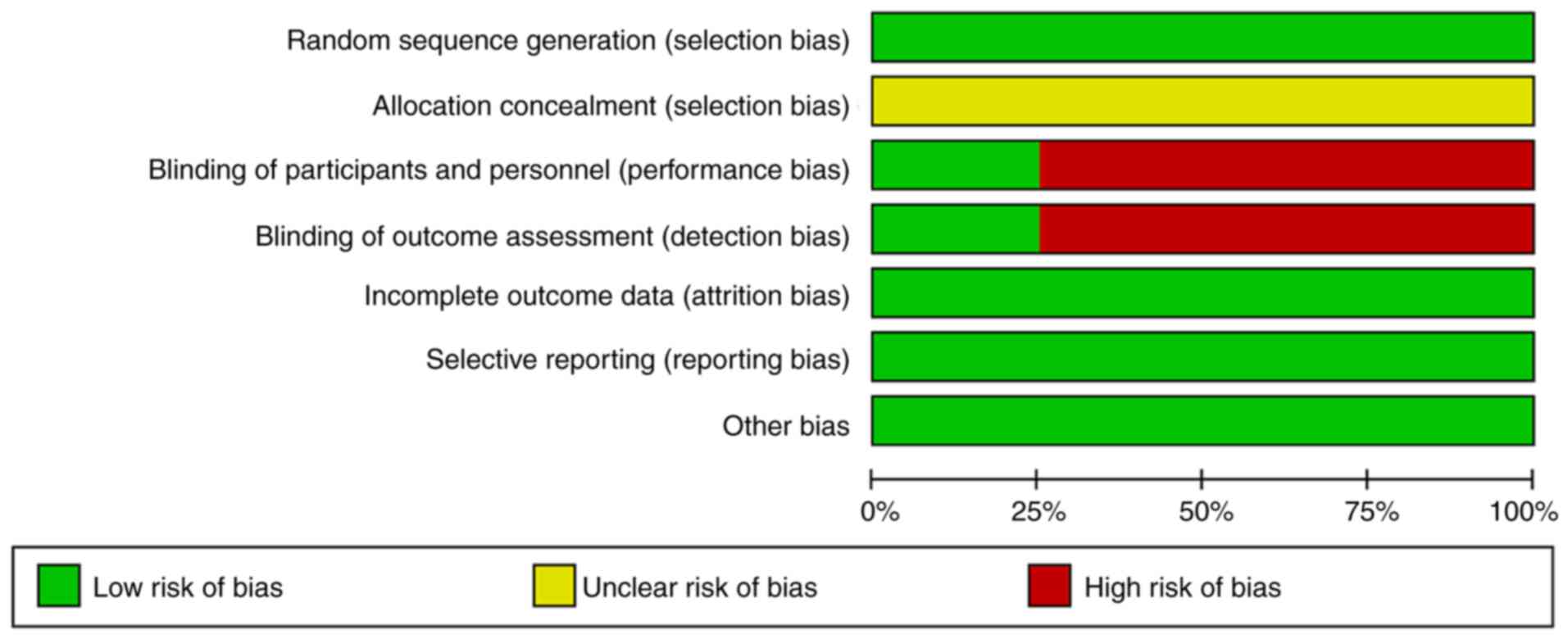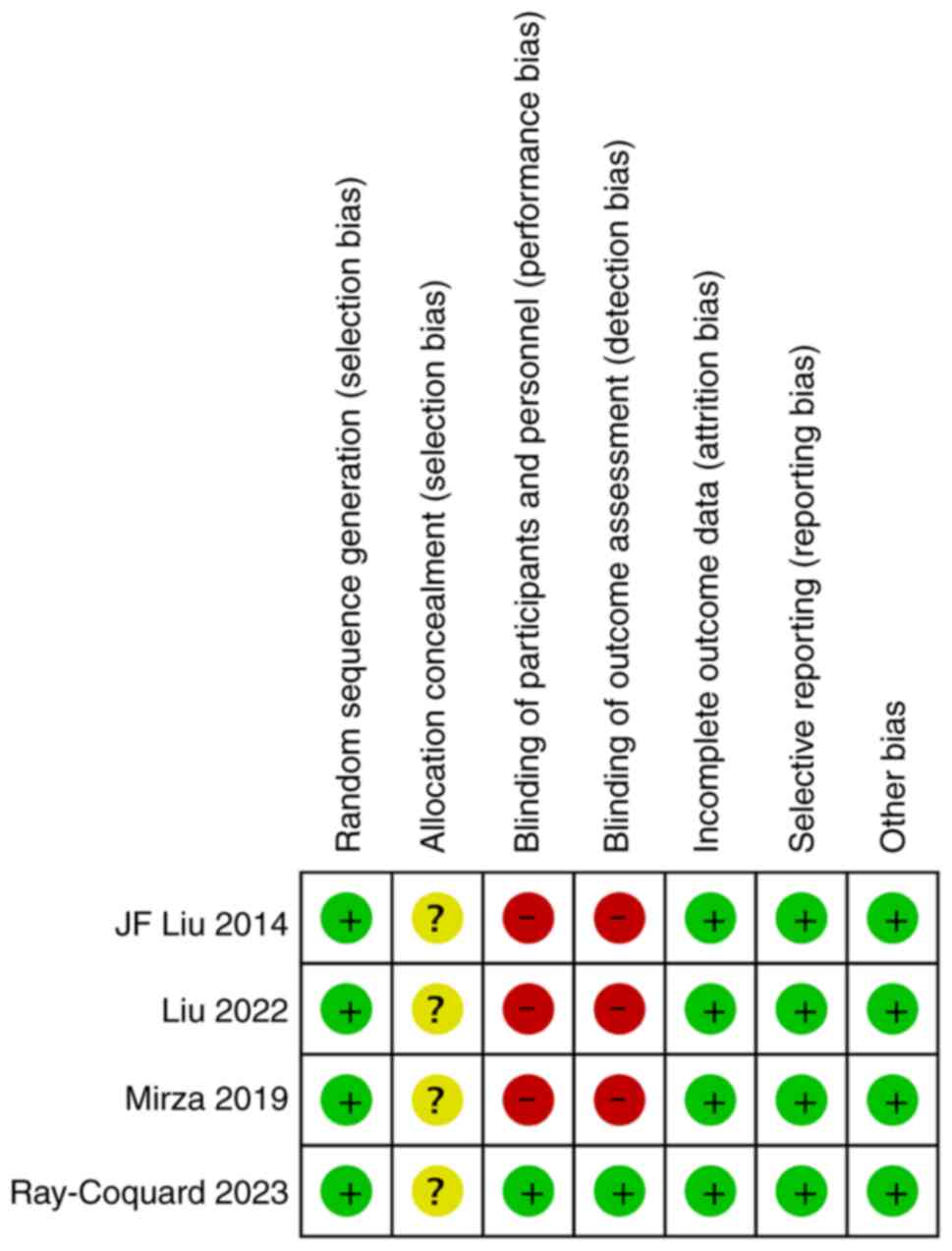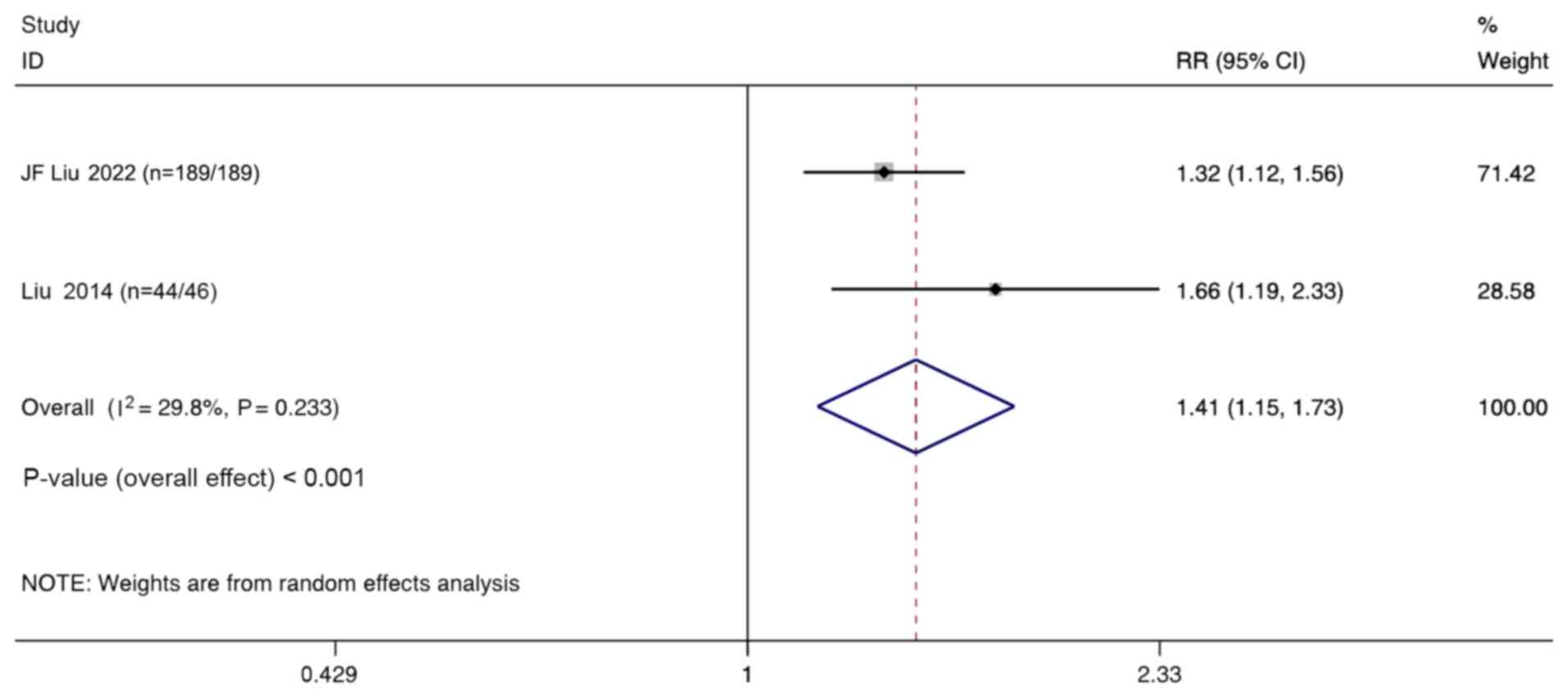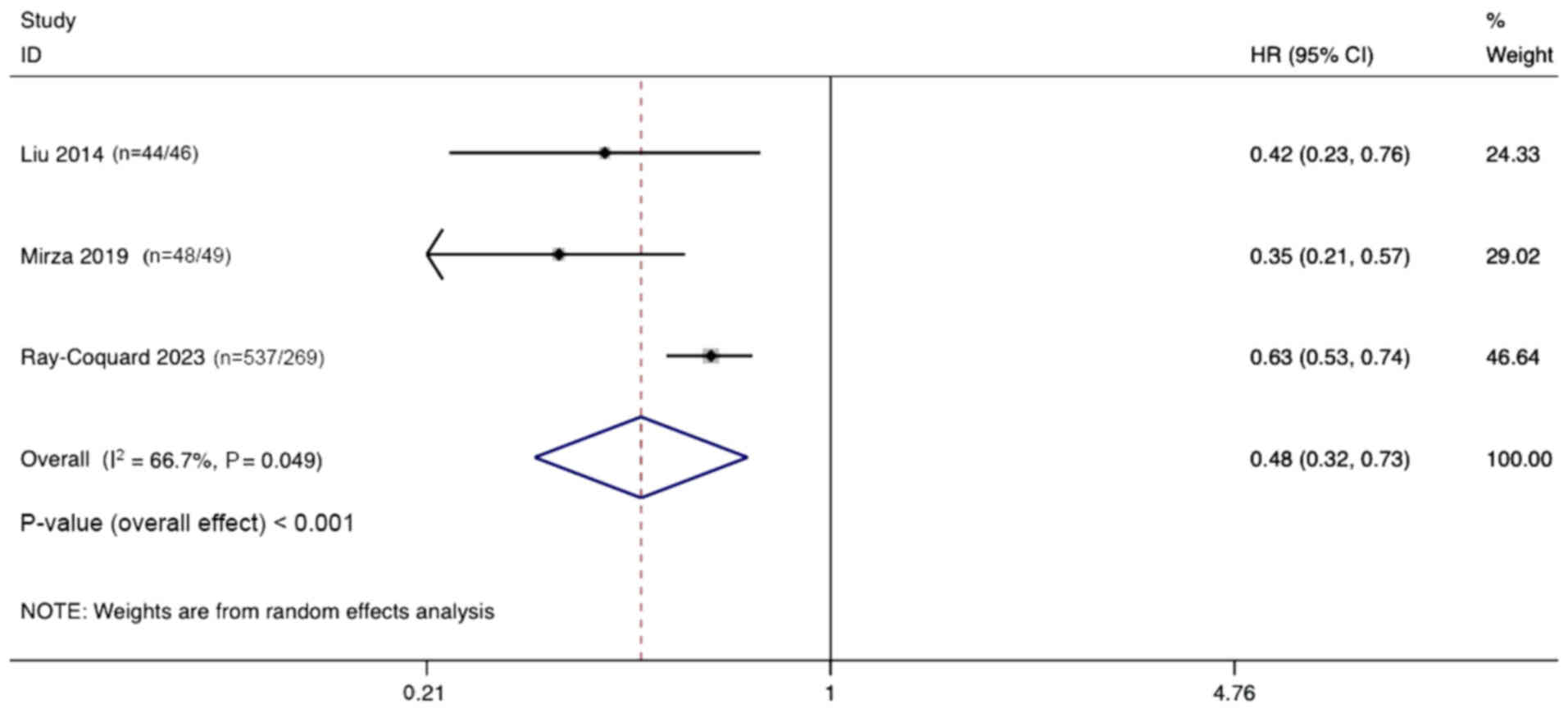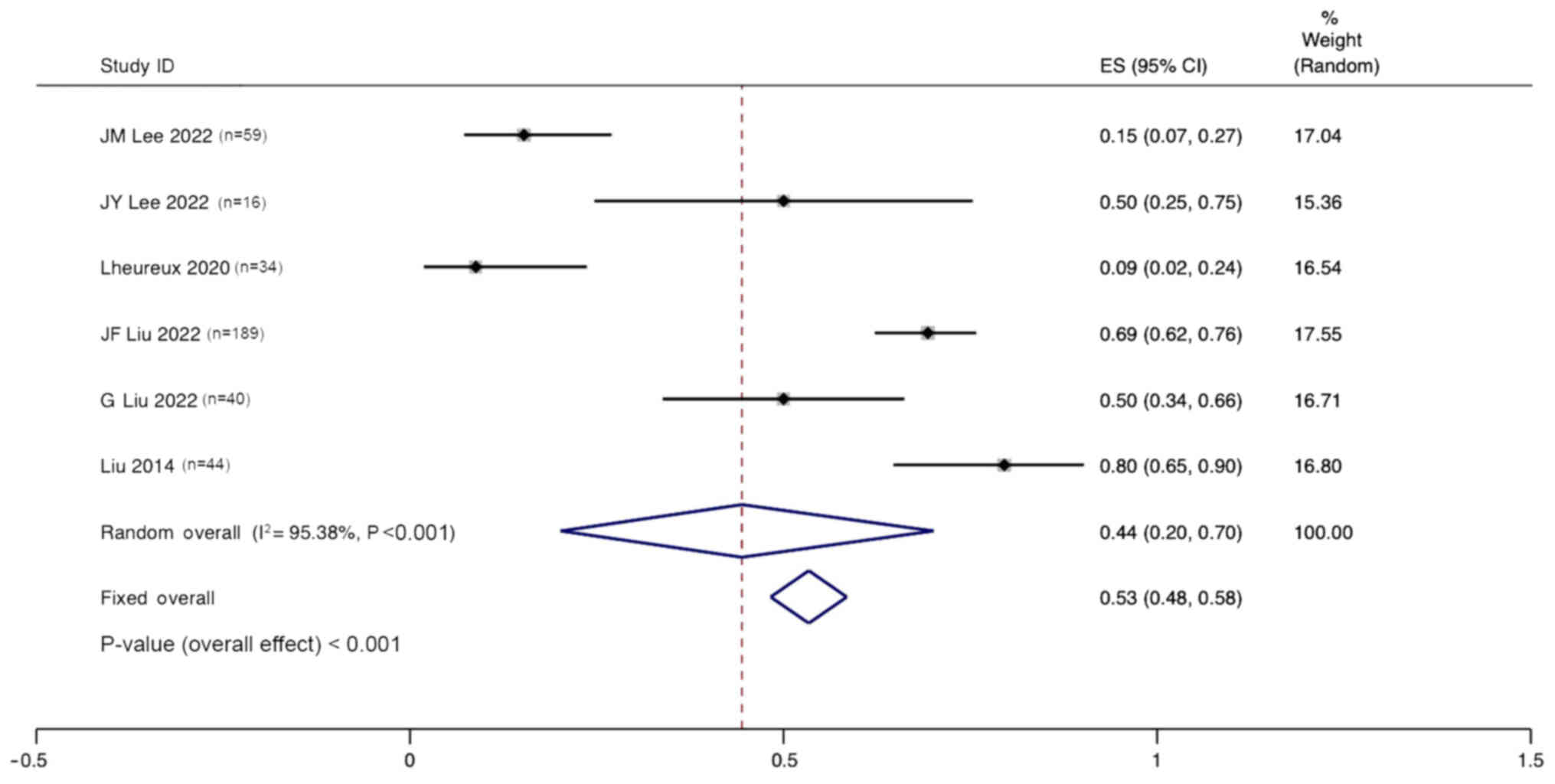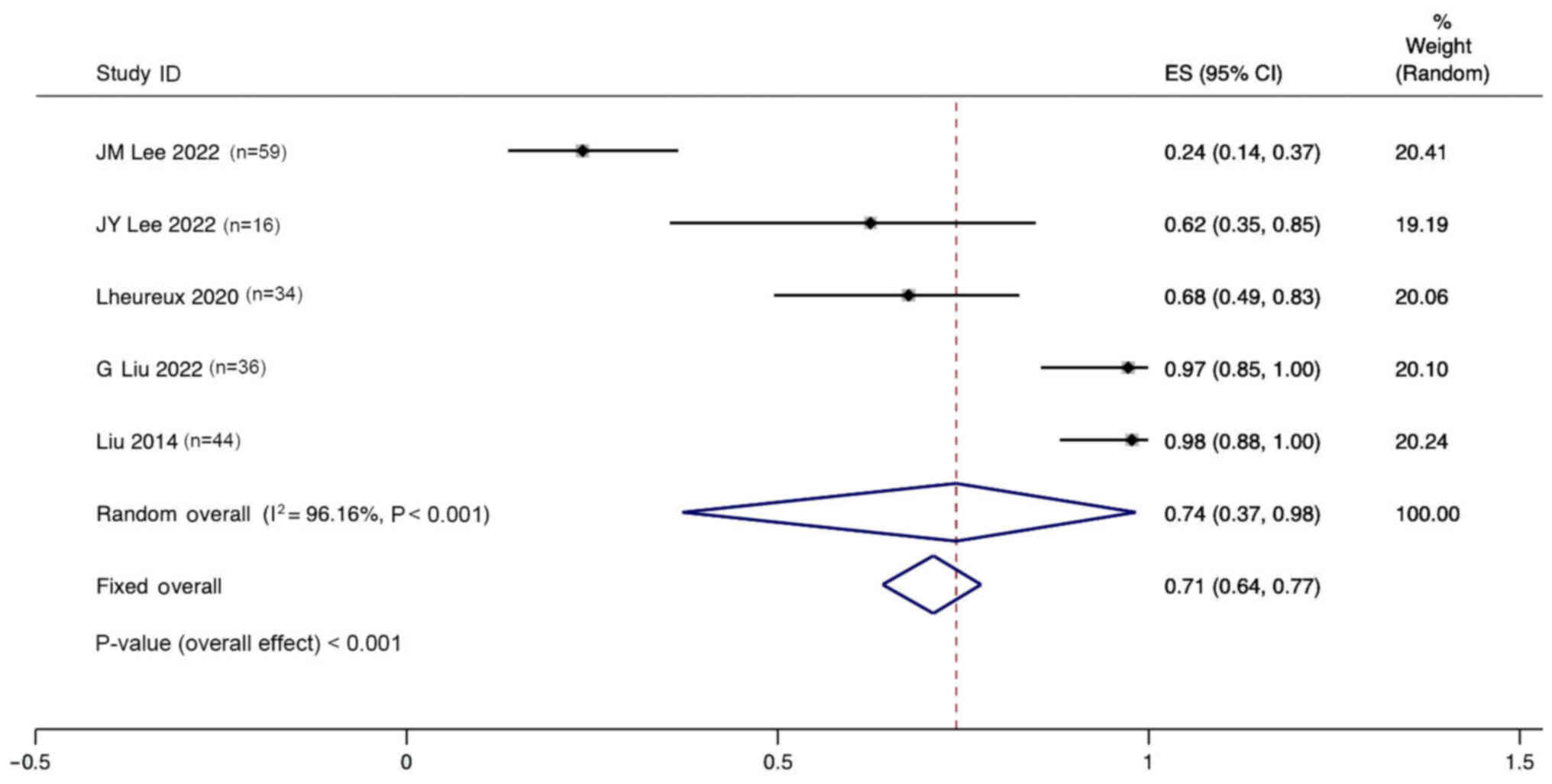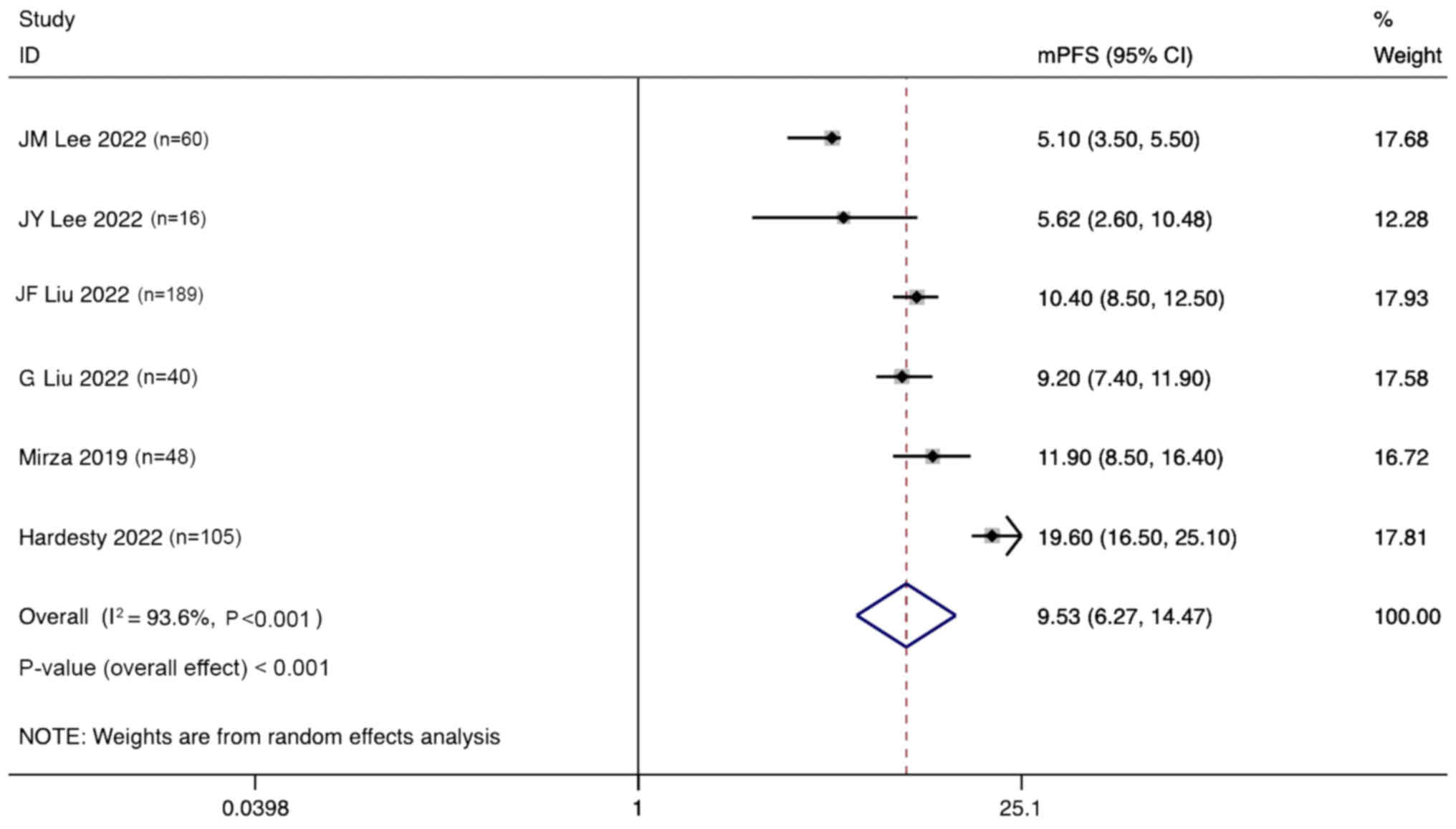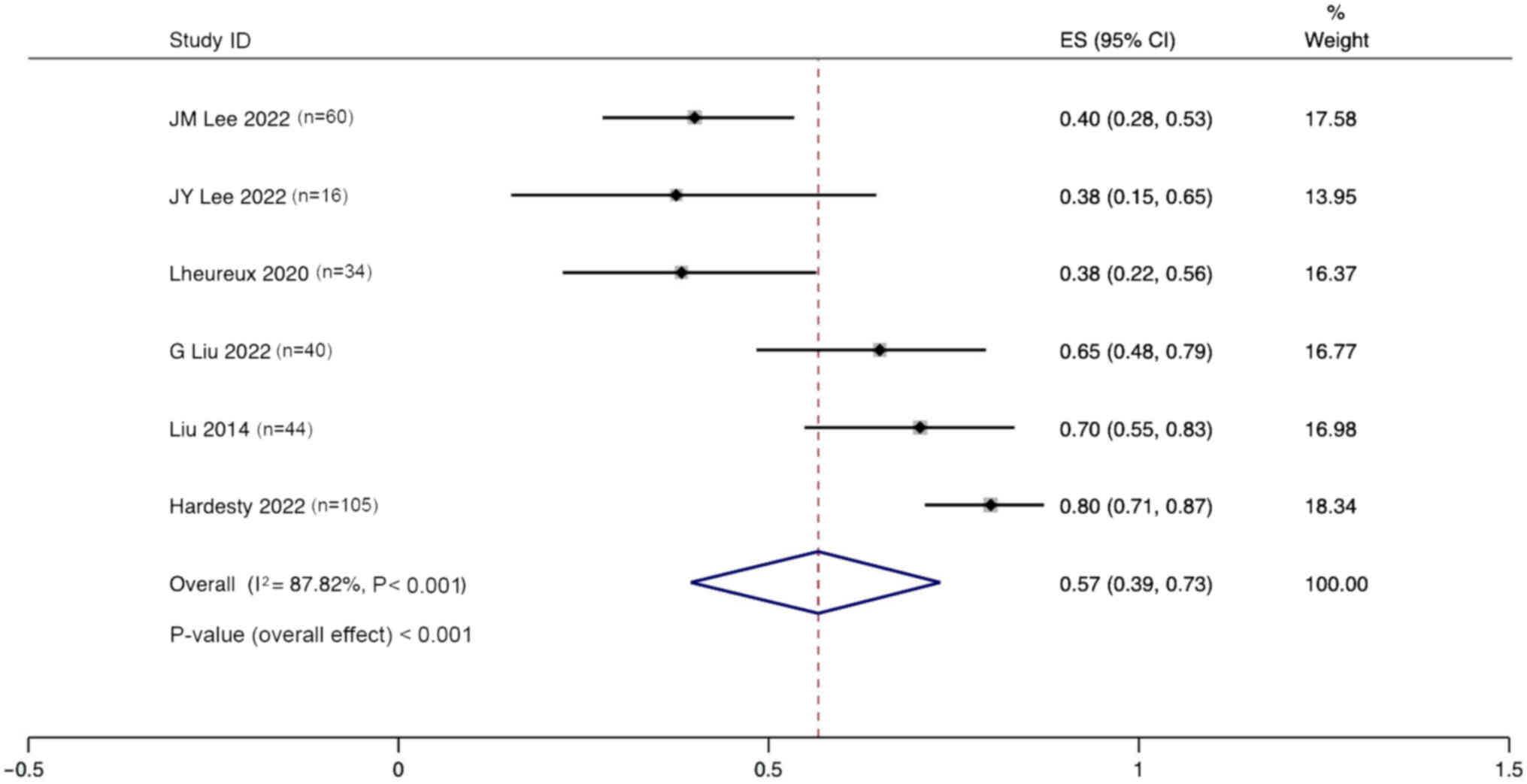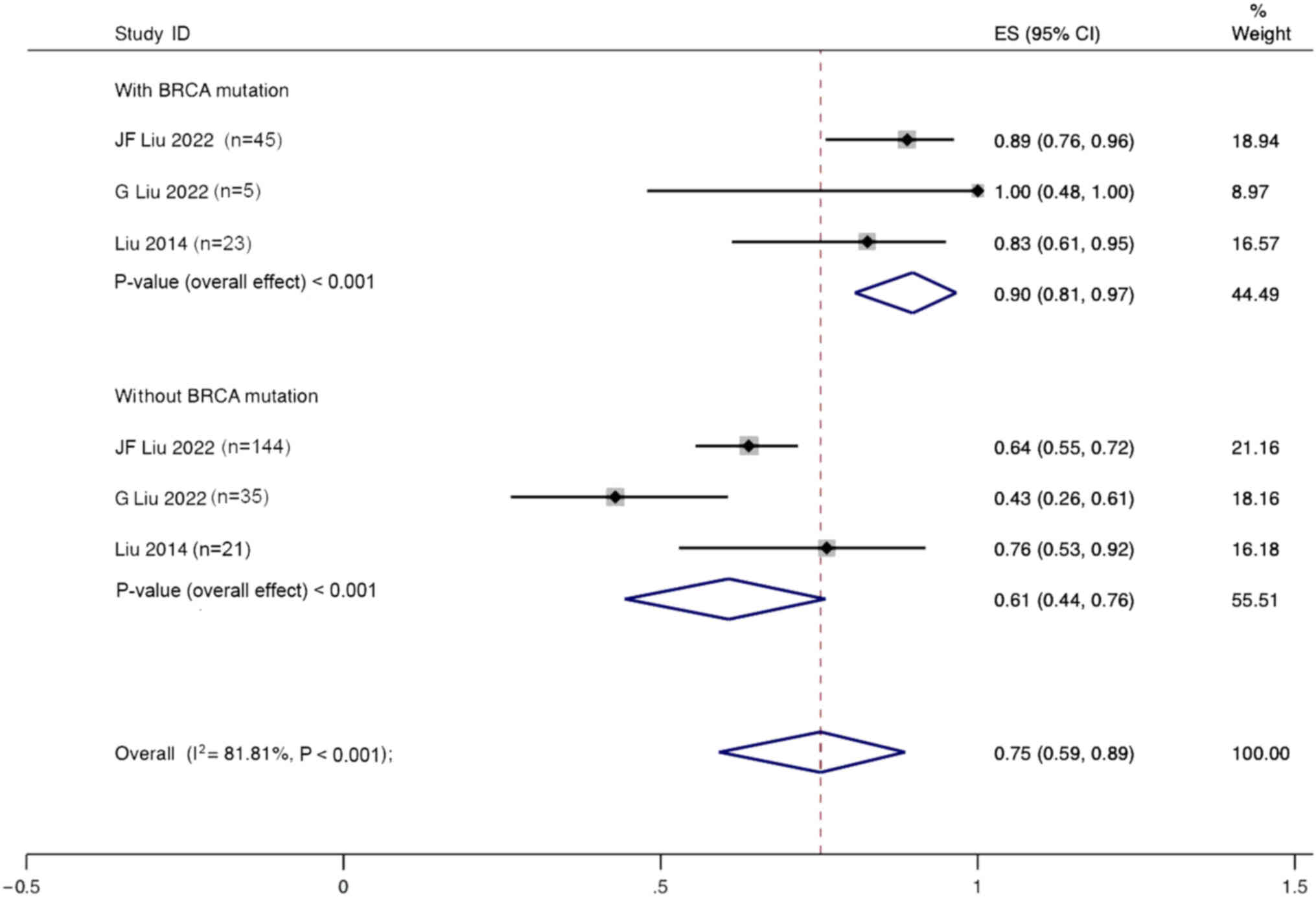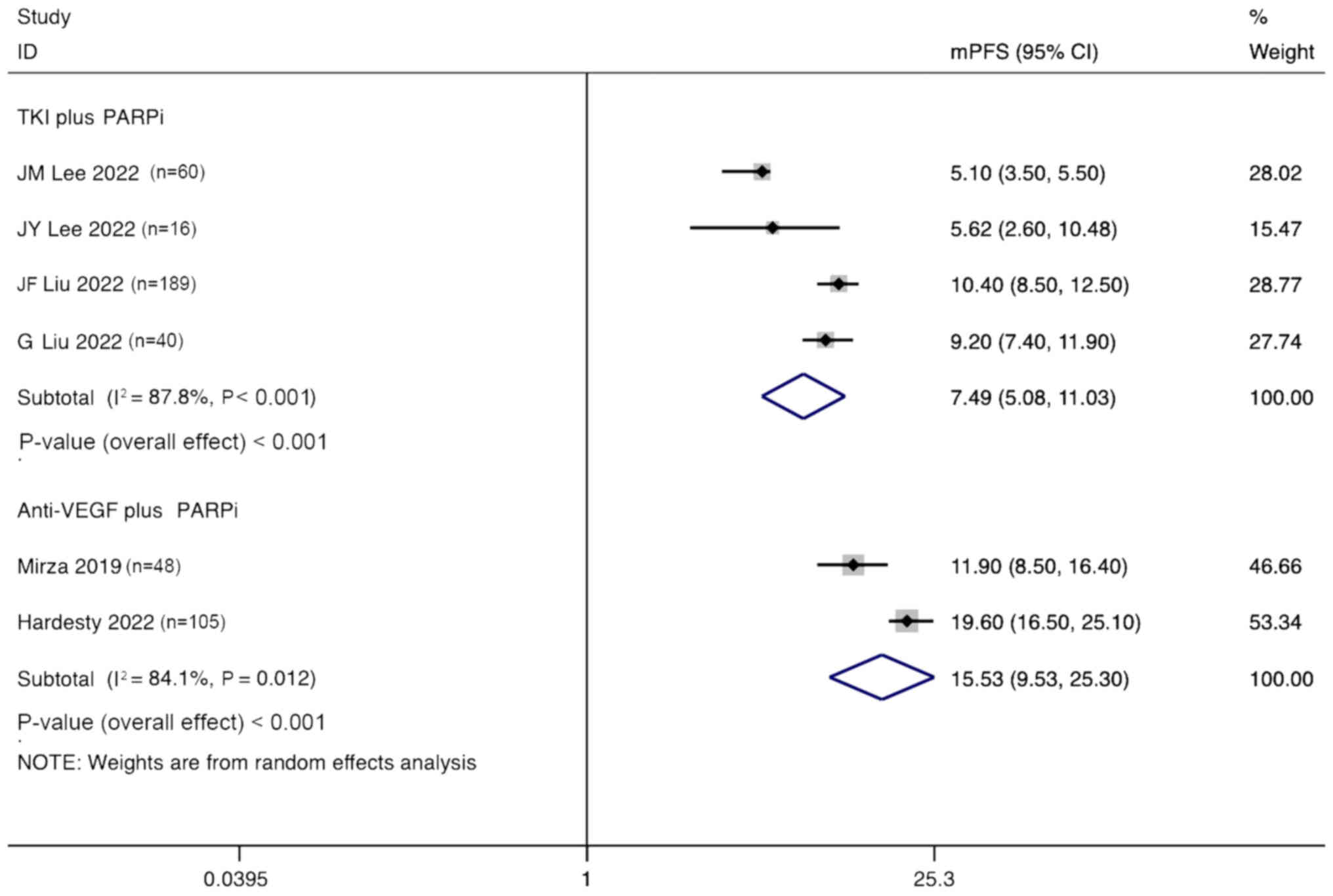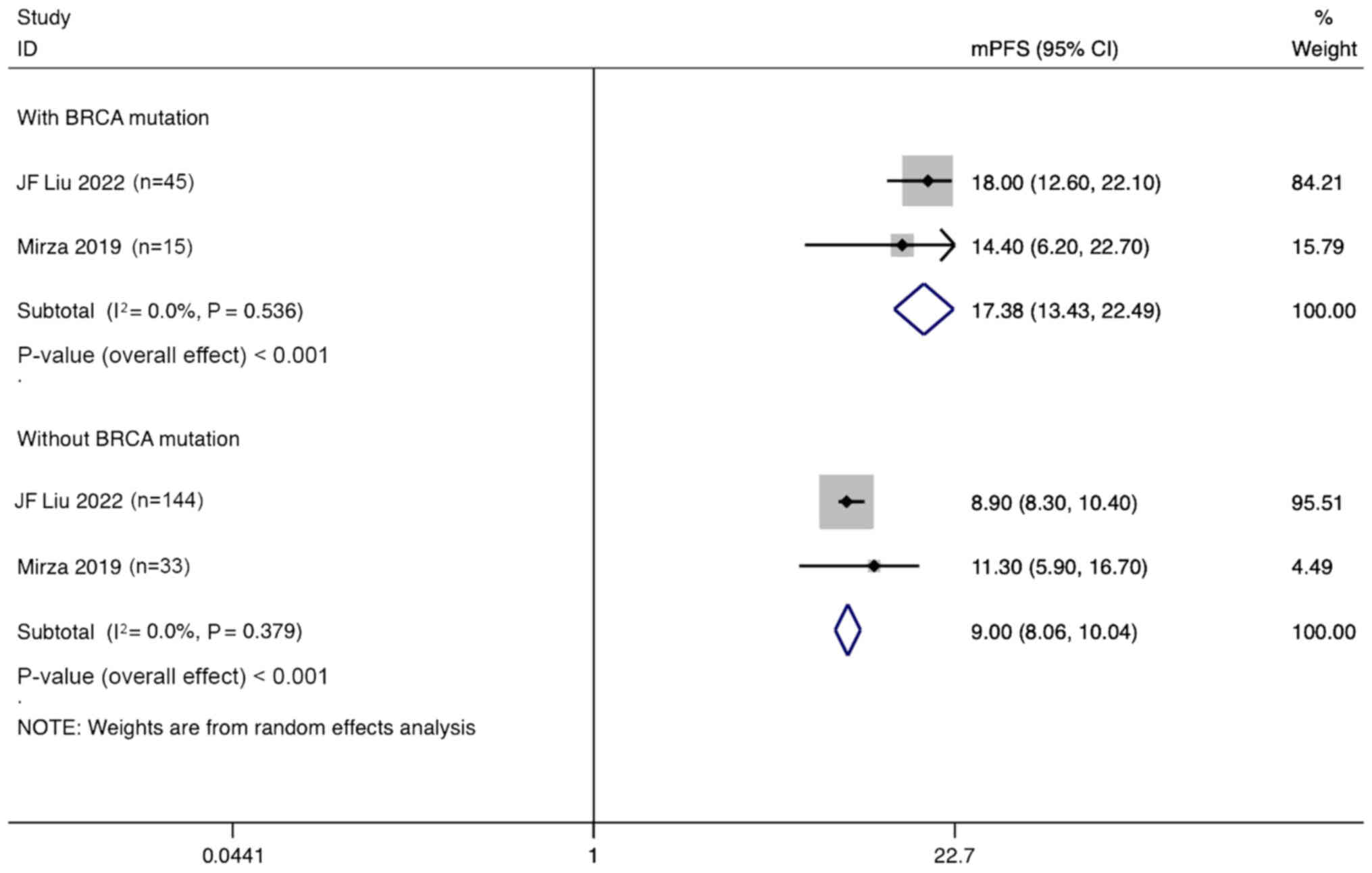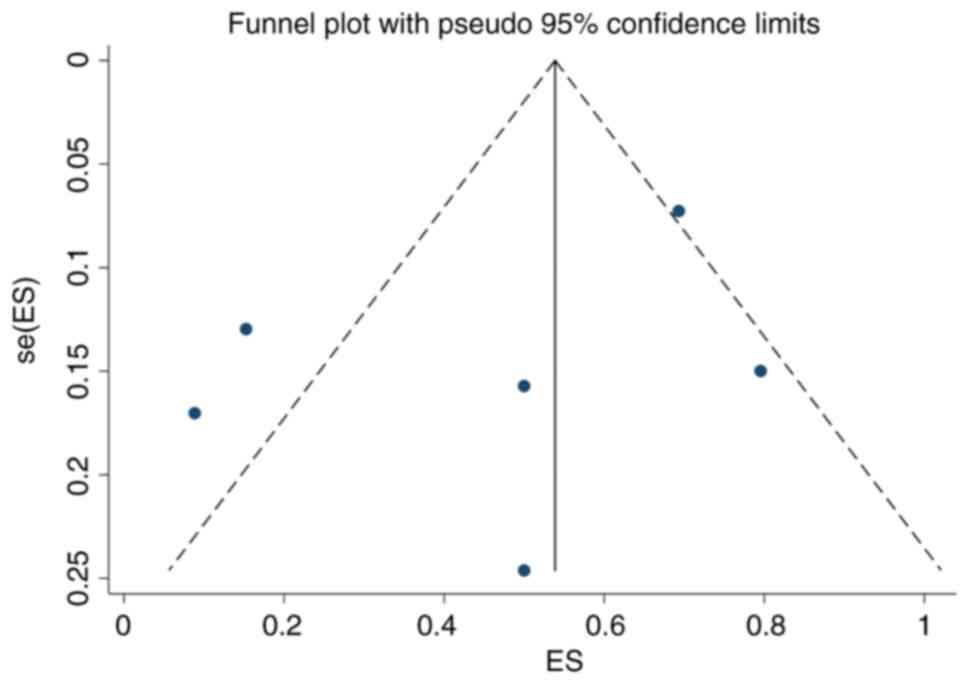Efficacy and safety of different angiogenesis inhibitors combined with PARP inhibitors in the treatment of ovarian cancer: A systematic review and meta‑analysis
- Authors:
- Published online on: October 29, 2024 https://doi.org/10.3892/ol.2024.14782
- Article Number: 36
-
Copyright: © Huang et al. This is an open access article distributed under the terms of Creative Commons Attribution License.
Abstract
Introduction
Ovarian cancer is one of the leading causes of mortality among women with gynecological malignancies worldwide, primarily due to its asymptomatic nature in the early stages, which typically leads to a late diagnosis (1). The introduction of targeted therapies represents a major breakthrough in the treatment of ovarian cancer, as it has the potential to improve the survival rates and quality of life of patients (2). Among these targeted therapies, angiogenesis inhibitors and poly (ADP-ribose) polymerase inhibitors (PARPi) have played a leading role, targeting specific molecular pathways implicated in cancer progression and DNA repair, respectively (3,4). Different angiogenesis inhibitors and PARPi have been utilized due to their distinct mechanisms of action and varying effectiveness in targeting specific pathways involved in ovarian cancer progression (5). For example, anti-vascular endothelial growth factor (VEGF) agents such as bevacizumab specifically target the VEGF pathway and inhibit the formation of new blood vessels essential for tumor growth, while tyrosine kinase inhibitors (TKIs) such as anlotinib offer a broader inhibition of angiogenesis by targeting multiple receptors (6). These differences may account for the variability in clinical outcomes observed for combinations with PARPi, which impair the DNA repair mechanisms of cancer cells. Understanding these mechanisms provides a rationale for the selection of particular combinations based on the unique clinical and molecular context of each patient.
Angiogenesis plays a pivotal role in tumor growth and metastasis, as it facilitates the supply of nutrients and oxygen to the tumor (7). Anti-angiogenic therapies, particularly those targeting the VEGF pathway, have shown promise in the inhibition of tumor vascularization (8). Conversely, PARPi exploit the concept of synthetic lethality to selectively kill cancer cells with homologous recombination deficiencies by further impairing their DNA repair capabilities (9). This approach has been demonstrated to be particularly effective in BRCA-mutated ovarian cancer, in which the DNA repair mechanisms are already compromised (10).
Mutations of the BRCA1 and BRCA2 genes are known to impair homologous recombination, a critical DNA repair pathway. Patients with these mutations are more susceptible to DNA damage, making them particularly responsive to PARPi therapy, which further disrupts the already weakened DNA repair mechanisms. Therefore, the presence of BRCA mutations has become an important predictive biomarker for the efficacy of PARPi, which can be used to guide personalized treatment approaches in ovarian cancer (11).
Recent research has posited the potential for synergistic effects when angiogenesis inhibitors and PARPi are combined. The rationale is that inhibiting angiogenesis while simultaneously blocking DNA repair pathways may lead to enhanced tumor regression (12). However, the evidence to date has been mixed, with a significant heterogeneity in outcomes across studies, which has prompted the suggestion that a more comprehensive analysis is necessary to obtain an improved understanding of the efficacy and safety of these combination therapies (13).
Patient-specific factors, such as BRCA mutation status, have emerged as crucial determinants of the response to these treatments (14). A recent systematic review and meta-analysis by Wei et al (15) focused on the overall efficacy and safety of PARP inhibitors combined with antiangiogenic agents in ovarian cancer and analyzed the general effects of such combinations. By contrast, the aim of the present study was to investigate the efficacy of different types of antiangiogenic agents when used in combination with PARP inhibitors. Furthermore, the impact of BRCA mutation status on the effectiveness of these combined treatments were explored. By addressing these two aspects, the present study provides a more comprehensive and personalized understanding of how the type of antiangiogenic agent and the BRCA mutation status both influence treatment outcomes in ovarian cancer. Through this approach, it is hoped to obtain a granular understanding of treatment efficacy and safety profiles, ultimately guiding clinical decision-making and contributing to personalized medicine strategies.
Materials and methods
Literature inclusion and exclusion criteria
Inclusion criteriaThe inclusion criteria were as follows: i) Study design: Randomized controlled trials (RCTs) and single-arm trials on the combined treatment of ovarian cancer with anti-angiogenic agents combined with PARPi. The language was limited to English. ii) Study subjects: Patients with a confirmed diagnosis of ovarian cancer were included without restrictions on race or age. iii) Interventions: In the control group, if included, the patients received monotherapy with anti-angiogenic agents or PARPi, and in the experimental group, patients received combination therapy using anti-angiogenic agents and PARPi. iv) Outcome measures: The objective response rate (ORR), disease control rate (DCR), median progression-free survival (mPFS) and incidence of adverse events (grade >3) were assessed.
Exclusion criteria
The exclusion criteria were as follows: i) Case reports, review articles and duplicates of previously published studies. ii) Studies on animals and basic research. iii) Literature not meeting the inclusion criteria. iv) Studies with flawed research designs or treatment measures unrelated to the experiment. v) Literature without valid information and data.
Literature search
The literature search was conducted using Embase (https://www.embase.com/), PubMed (https://pubmed.ncbi.nlm.nih.gov/) and The Cochrane Library (https://www.cochranelibrary.com/) databases. The publication dates searched for were from database inception until February 2024. The search terms were a combination of MeSH terms and entry terms. The search terms included: (((((((((((‘ovarian neoplasms’[Mesh]) OR (ovarian neoplasm [Title/Abstract])) OR (ovary neoplasms[Title/Abstract])) OR (ovary neoplasm [Title/Abstract])) OR (ovary cancer[Title/Abstract])) OR (ovary cancers[Title/Abstract])) OR (ovarian cancer [Title/Abstract])) OR (ovarian cancers[Title/Abstract])) OR (cancer of ovary[Title/Abstract])) OR (cancer of the ovary[Title/Abstract])) AND ((((niraparib[Title/Abstract]) OR (olaparib[Title/Abstract])) OR (veliparib[Title/Abstract])) OR (rucaparib[Title/Abstract]))) AND (((((anlotinib [Title/Abstract]) OR (cediranib[Title/Abstract])) OR (bevacizumab [Title/Abstract])) OR (sorafenib[Title/Abstract])) OR (apatinib[Title/Abstract])).
Data extraction
Two researchers independently conducted the screening and data extraction based on the inclusion and exclusion criteria. In case of discrepancies between the two researchers, disagreements were resolved through discussion or, if needed, with the judgement of the third researcher.
Literature quality assessment
Two independent researchers used the Methodological Index for Non-Randomized Studies (MINORS) (16) to evaluate the quality of evidence for each study. This index includes 12 items, each with a mean score of 0–2, giving a maximum total of 24 points. The studies are categorized by score as ‘moderate quality’, defined as a score of 9–16, and ‘high quality’, defined as a score of 17–24. For RCTs, Review manager 5.3 software risk assessment tool was used to evaluate the included literature according to random sequence generation, allocation concealment, blinding, whether research results were blinded to review, completeness of outcome data, selection of reported research outcomes and other biases. The meta-analysis was performed in accordance with the guidelines of the Preferred Reporting Items for Systematic Reviews and Meta-analysis statement (17).
Data synthesis and statistical analysis
Data were analyzed using STATA 15.1 (StataCorp LLC) (18). The forest plots generated in this analysis visually represent the summary of individual study results, including key parameters such as the relative risk (RR), hazard ratio (HR) and effect size (ES), and the associated 95% confidence interval (95% CI). I2 was used to evaluate heterogeneity. If the test yielded P<0.1 and I2>50%, significant heterogeneity was indicated. If heterogeneity was indicated, whether any specific study was the source of the heterogeneity was identified using sensitivity analysis. In the sensitivity analysis, every trial was excluded individually and a combined analysis of the remaining trials was performed. Additionally, the contribution of each study to the pooled result was indicated by its %weight, which reflects the influence of the study based on its sample size and variability. Studies with larger sample sizes or lower variability provide a greater contribution to the overall estimate; thus, they contribute more heavily to the meta-analysis. A random-effects model was used for the pooling effect in all meta-analyses. Publication bias was analyzed using funnel plots and Egger's test, with P>0.05 indicating no publication bias.
Results
Literature search results
A total of 429 articles were initially identified for potential inclusion in the present study. After the exclusion of duplicate studies, 223 articles remained. After reading the titles and abstracts, a total of 140 articles were selected for further evaluation. Ultimately, 9 studies were integrated into the meta-analysis (Fig. 1) (19–27).
Baseline characteristics and quality assessment of the included studies
The 9 studies included in the study were conducted in various countries, namely the USA, Korea, Canada, China and Germany. They comprised 5 single-arm trials and 4 RCTs, with sample sizes ranging from 16 to 537 participants in the combination therapy groups. The interventions investigated were cediranib plus olaparib, anlotinib plus niraparib, and bevacizumab plus niraparib or olaparib, which reflect a diverse approach to the targeting of ovarian cancer. Age data, where available, indicate the participants ranged broadly from their 30 to 80s. However, 5 of the studies omitted specific data on BRCA mutation status, suggesting a gap in the genetic characterization of study populations. Quality assessment scores calculated using the MINORS criteria indicate that the included studies are of moderate to high quality, with scores between 17 and 19 (Table I).
The findings of quality assessment showed that the 4 RCT studies included in this review used random sequence generation. However, none of the studies described allocation concealment, and only one study used a double-blinding method (Figs. 2 and 3).
Meta-analysis results
ORRTwo studies compared the ORR of combination therapy with monotherapy in the treatment of ovarian cancer. Meta-analysis of the aggregated results using a random-effect model indicates that the ORR in the combination therapy group was significantly higher than that in the monotherapy group (RR, 1.41; 95% CI, 1.15–1.73; P<0.001; Fig. 4).
HR of PFS
Three studies documented the differences in PFS between combination therapy and monotherapy in the treatment of ovarian cancer. Significant heterogeneity was observed (I2, 66.7%, P=0.049), and a random effects model was used. The pooled results indicate that combination therapy significantly prolongs PFS for ovarian cancer treatment compared with monotherapy (HR, 0.48; 95% CI, 0.32–0.73; P<0.001; Fig. 5).
ORR of combination therapy
Six studies reported the ORR for the treatment of ovarian cancer with angiogenesis inhibitors combined with PARPi. Significant heterogeneity was observed (I2, 95.38%; P<0.001), and a random effects model was used. The pooled results indicate that the ORR for the treatment of ovarian cancer with anti-angiogenic agents combined with PARPi was 44% (95% CI, 20–70%; Fig. 6).
DCR of combination therapy
Five studies reported the DCR for the treatment of ovarian cancer with angiogenesis inhibitors combined with PARPi. Significant heterogeneity was observed (I2, 96.16%; P<0.001), and a random effects model was used. The pooled results indicate that the DCR for the treatment of ovarian cancer with anti-angiogenic agents combined with PARPi was 74% (95% CI, 37–98%; Fig. 7).
mPFS
Six studies reported the mPFS for the treatment of ovarian cancer with angiogenesis inhibitors combined with PARPi. Significant heterogeneity was observed (I2, 93.6%; P<0.001), and a random effects model was used. The pooled results indicate that the mPFS for the treatment of ovarian cancer with anti-angiogenic agents combined with PARPi was 9.53 months (95% CI, 6.27–14.47 months; Fig. 8).
Incidence of adverse events (grade >3)
Six studies reported the incidence of adverse events (grade >3) after the treatment of ovarian cancer with angiogenesis inhibitors combined with PARPi. Significant heterogeneity was observed (I2, 87.42%; P<0.001), and a random effects model was used. The pooled results indicate that the incidence of adverse events after the treatment of ovarian cancer with anti-angiogenic agents combined with PARPi was 57% (95% CI, 39–73%; Fig. 9).
Subgroup analyses
ORR of combination therapySubgroup analysis based on BRCA mutation status using a random effects model showed that the ORR for patients with ovarian cancer and BRCA mutations treated with angiogenesis inhibitors combined with PARPi was 90% (95% CI, 81–97%), whereas the ORR for patients without BRCA mutations was only 61% (95% CI, 44–76%) (Fig. 10).
mPFS
A random effects model was used to perform a subgroup analysis, based on the type of angiogenesis inhibitor used for the combination therapy of patients with ovarian cancer. The analysis showed that the mPFS for patients treated with TKIs combined with PARPi was 7.49 months (95% CI, 5.08–11.03 months), while the mPFS for patients treated with anti-VEGF agents combined with PARPi was 15.53 months (95% CI, 9.53–25.30 months) (Fig. 11).
Additionally, a subgroup analysis based on the presence of BRCA mutations showed that ovarian cancer patients with BRCA mutations treated with angiogenesis inhibitors combined with PARPi had a mPFS of 17.38 months (95% CI, 13.43–22.49 months). By contrast, the mPFS for patients without BRCA mutations was only 9.00 months (95% CI, 8.06–10.04 months) (Fig. 12).
Sensitivity analysis
The sensitivity analysis indicated that no study had a great influence on the results, suggesting that the results of the present study are reliable and stable (Fig. S1, Fig. S2, Fig. S3, Fig. S4, Fig. S5).
Publication bias
A funnel plot was constructed for the present meta-analysis (Fig. 13). It is largely symmetrical, with P=0.330 from Egger's test, indicating that there was no significant publication bias in the present meta-analysis.
Discussion
The present meta-analysis provides a critical evaluation of the efficacy and safety of different angiogenesis inhibitors combined with PARPi in the treatment of ovarian cancer. The results demonstrate a significant improvement in ORR and mPFS when combination therapy is employed compared with monotherapy. Notably, the subgroup analysis revealed distinct differences in efficacy between TKIs and anti-VEGF agents when combined with PARPi, highlighting the complexity involved in the optimization of combination therapy for patients with ovarian cancer.
Combination therapy had a pooled ORR of 44%, and induced a marked improvement in mPFS, underscoring the therapeutic potential of this strategy. Such findings align with previous research suggesting that the simultaneous inhibition of angiogenesis and DNA repair pathways can synergistically hinder tumor growth (28,29). In present study, the superior performance of anti-VEGF agents over TKIs in the treatment of ovarian cancer, as indicated by a mPFS of 15.53 months compared with 7.49 months, respectively, suggests that the specificity of anti-VEGF agents in targeting the VEGF pathway may confer a more potent anti-angiogenic effect, thereby enhancing the effectiveness of PARPi. Moreover, the pronounced benefit in ORR and mPFS observed in patients with BRCA mutations compared with those without BRCA mutations when treated with anti-VEGF agents and PARPi emphasizes the importance of genetic profiling in tailoring treatment strategies. This supports the notion that individuals with inherent DNA repair deficiencies are more susceptible to treatments targeting DNA repair mechanisms, a concept that is gaining traction in personalized oncology (30). The clinical translation of these insights necessitates a nuanced approach, underpinned by the principles of precision medicine. The differential treatment outcomes observed indicate that it is imperative to adopt a more individualized approach to treatment planning. This entails leveraging the comprehensive genetic and molecular profiling of tumors to discern patient-specific vulnerabilities that these combination therapies can exploit (31). For instance, the distinct advantage observed in patients with BRCA mutations when treated with this combination therapy underscores the importance of genetic markers in predicting therapeutic success (32). This stratification not only aids in the identification of candidates likely to derive the most benefit but also in the tailoring of treatment regimens to mitigate potential adverse effects, thus optimizing patient outcomes. Moreover, the variance in efficacy between different classes of angiogenesis inhibitors when used in conjunction with PARPi suggests a pivotal area for future clinical research. It beckons the design of clinical trials aimed at elucidating the underlying mechanisms of this differential response, which could, in turn, inform the development of more effective combination strategies (33). Such endeavors would not only contribute to the refinement of current treatment paradigms but also assist in the identification of novel therapeutic targets within these pathways.
Despite the promising findings of the present meta-analysis, the marked heterogeneity observed across the studies underscores the complexity of ovarian cancer treatment. This variability highlights that personalized approaches, involving the consideration of genetic and molecular tumor profiles, are necessary to optimize therapeutic outcomes. Furthermore, the 57% incidence of adverse events (grade >3) in patients treated with combination therapy indicates that cautious patient management is necessary and underscores the necessity for ongoing research into the mitigation of treatment-related toxicities.
The present study has certain limitations, Firstly, there is some heterogeneity among the studies, which might be attributed to the different PARPi used. Future studies are necessary in which more unified research designs and more consistent patient cohorts are implemented. Additionally, most of the included studies focused on short-term treatment effects, such as the ORR and mPFS, and data on long-term or OS rates, quality of life and follow-up after treatment are lacking. Therefore, our understanding of the long-term benefits of these treatment strategies remains limited. Another limitation of the present study is the relatively small sample size, as only a small number of studies met the rigorous inclusion criteria from an initial pool of 140 articles. This may affect the generalizability and consistency of the findings. Despite this, meta-analytical techniques and sensitivity analyses were employed to ensure the robustness of the results, although the small sample size remains a consideration.
In conclusion, the present study highlights the significant therapeutic potential of combining angiogenesis inhibitors with PARPi in the treatment of ovarian cancer. The findings suggest that this combination therapy can offer enhanced efficacy, particularly in patients with BRCA mutations, who are more likely to benefit from the combined effects of these agents. The comparative analysis between TKIs and anti-VEGF agents reveals distinct differences in their effectiveness, emphasizing the importance of selecting the appropriate angiogenesis inhibitor based on the molecular and genetic characteristics of the tumor.
The results underscore the critical requirement for personalized treatment strategies that leverage comprehensive genetic and molecular profiling to optimize therapeutic outcomes. While the combination of angiogenesis inhibitors and PARPi shows promise, further research is necessary to fully understand the long-term benefits and potential risks of such combinations, particularly regarding OS. Future studies should also explore the development of biomarkers to better predict patient response and refine treatment protocols, which should ultimately advance the field of ovarian cancer therapy.
Supplementary Material
Supporting Data
Acknowledgements
Not applicable.
Funding
Funding: No funding was received.
Availability of data and materials
The data generated in the present study may be requested from the corresponding author.
Authors' contributions
XH and JL made substantial contributions to conception and design. XH wrote the manuscript and JL created the figures. LG participated in the acquisition of data. XH and LG confirm the authenticity of all the raw data. All authors read and approved the final version of the manuscript.
Ethics approval and consent to participate
Not applicable.
Patient consent for publication
Not applicable.
Competing interests
The authors declare that they have no competing interests.
References
|
Dexter JM, Brubaker LA, Bitler BG, Goff BA, Menon U, Moore KN, Sundaram KM, Walsh CS, Guntupalli SR and Behbakht K: Ovarian cancer think tank: An overview of the current status of ovarian cancer screening and recommendations for future directions. Gynecol Oncol Rep. 53:1013762024. View Article : Google Scholar : PubMed/NCBI | |
|
Wilson EM, Eskander RN and Binder PS: Recent therapeutic advances in gynecologic oncology: A review. Cancers (Basel). 16:7702024. View Article : Google Scholar : PubMed/NCBI | |
|
Hirschl N, Leveque W, Granitto J, Sammarco V, Fontillas M and Penson RT: PARP inhibitors: Strategic use and optimal management in ovarian cancer. Cancers (Basel). 16:9322024. View Article : Google Scholar : PubMed/NCBI | |
|
Goldlust IS, Guidice E and Lee JM: PARP inhibitors in ovarian cancer. Semin Oncol. 51:45–57. 2024. View Article : Google Scholar : PubMed/NCBI | |
|
Lord CJ and Ashworth A: PARP inhibitors: Synthetic lethality in the clinic. Science. 355:1152–1158. 2017. View Article : Google Scholar : PubMed/NCBI | |
|
Ferrara N, Hillan KJ, Gerber HP and Novotny W: Discovery and development of bevacizumab, an anti-VEGF antibody for treating cancer. Nat Rev Drug Discov. 3:391–400. 2004. View Article : Google Scholar : PubMed/NCBI | |
|
Min T, Lee SH and Lee S: Angiogenesis and apoptosis: Data comparison of similar microenvironments in the corpus luteum and tumors. Animals (Basel). 14:11182024. View Article : Google Scholar : PubMed/NCBI | |
|
Wei Q and Zhang YH: Flavonoids with anti-angiogenesis function in cancer. Molecules. 29:15702024. View Article : Google Scholar : PubMed/NCBI | |
|
Ratnaparkhi R, Javellana M, Jewell A and Spoozak L: Evaluation of homologous recombination deficiency in ovarian cancer. Curr Treat Options Oncol. 25:237–260. 2024. View Article : Google Scholar : PubMed/NCBI | |
|
Collet L, Hanvic B, Turinetto M, Treilleux I, Chopin N, Le Saux I and Ray-Coquard I: BRCA1/2 alterations and reversion mutations in the area of PARP inhibitors in high grade ovarian cancer: State of the art and forthcoming challenges. Front Oncol. 14:13544272024. View Article : Google Scholar : PubMed/NCBI | |
|
Dellino M, D'Amato A, Battista G, Cormio G, Vimercati A, Loizzi V, Lagana AS, Damiani GR, Favilli A, Gerli S, et al: Reproductive outcomes in women with BRCA 1/2 germline mutations: A retrospective observational study and literature review. Open Med (Wars). 19:202499992024. View Article : Google Scholar : PubMed/NCBI | |
|
Hockings H and Miller RE: The role of PARP inhibitor combination therapy in ovarian cancer. Ther Adv Med Oncol. 15:175883592311731832023. View Article : Google Scholar : PubMed/NCBI | |
|
Yi XF, Gao RL, Sun L, Wu ZX, Zhang SL, Huang LT, Han CB and Ma JT: Dual antitumor immunomodulatory effects of PARP inhibitor on the tumor microenvironment: A counterbalance between anti-tumor and pro-tumor. Biomed Pharmacother. 163:1147702023. View Article : Google Scholar : PubMed/NCBI | |
|
Szentmartoni G, Muhl D, Csanda R, Szasz AM, Herold Z and Dank M: Predictive value and therapeutic significance of somatic BRCA mutation in solid tumors. Biomedicines. 12:5932024. View Article : Google Scholar : PubMed/NCBI | |
|
Wei Y, He L, Liu T, Guo T, Xie C, Jia J, Lin Y, Liu J and Fan J: Efficacy and safety of PARP inhibitors combined with antiangiogenic agents in the maintenance treatment of ovarian cancer: A systematic review and meta-analysis with trial sequential analysis of randomized controlled trials. Front Pharmacol. 15:13720772024. View Article : Google Scholar : PubMed/NCBI | |
|
Slim K, Nini E, Forestier D, Kwiatkowski F, Panis Y and Chipponi J: Methodological index for non-randomized studies (minors): Development and validation of a new instrument. ANZ J Surg. 73:712–716. 2003. View Article : Google Scholar : PubMed/NCBI | |
|
Bernardo WM: PRISMA statement and PROSPERO. Int Braz J Urol. 43:383–384. 2017. View Article : Google Scholar : PubMed/NCBI | |
|
Guo LL, Cheng TP, Feng LX, Feng J and Li XY: Incidence and risk factors for deep infection after primary shoulder arthroplasty: A meta-analysis. Eur Rev Med Pharmacol Sci. 26:4606–4613. 2022.PubMed/NCBI | |
|
Lee JM, Moore RG, Ghamande S, Park MS, Diaz JP, Chapman J, Kendrick J, Slomovitz BM, Tewari KS, Lowe ES, et al: Cediranib in combination with olaparib in patients without a germline BRCA1/2 mutation and with recurrent platinum-resistant ovarian cancer: Phase IIb CONCERTO trial. Clin Cancer Res. 28:4186–4193. 2022. View Article : Google Scholar : PubMed/NCBI | |
|
Lee JY, Kim BG, Kim JW, Lee JB, Park E, Joung JG, Kim S, Choi CH and Kim HS; Korean Gynecologic Oncology Group (KGOG) investigators, : Biomarker-guided targeted therapy in platinum-resistant ovarian cancer (AMBITION; KGOG 3045): A multicentre, open-label, five-arm, uncontrolled, umbrella trial. J Gynecol Oncol. 33:e452022. View Article : Google Scholar : PubMed/NCBI | |
|
Lheureux S, Oaknin A, Garg S, Bruce JP, Madariaga A, Dhani NC, Bowering V, White J, Accardi S, Tan Q, et al: EVOLVE: A multicenter open-label single-arm clinical and translational phase II trial of cediranib plus olaparib for ovarian cancer after PARP inhibition progression. Clin Cancer Res. 26:4206–4215. 2020. View Article : Google Scholar : PubMed/NCBI | |
|
Liu JF, Brady MF, Matulonis UA, Miller A, Kohn EC, Swisher EM, Cella D, Tew WP, Cloven NG, Muller CY, et al: Olaparib with or without cediranib versus platinum-based chemotherapy in recurrent platinum-sensitive ovarian cancer (NRG-GY004): A randomized, open-label, phase III trial. J Clin Oncol. 40:2138–2147. 2022. View Article : Google Scholar : PubMed/NCBI | |
|
Liu G, Feng Y, Li J, Deng T, Yin A, Yan L, Zheng M, Xiong Y, Li J, Huang Y, et al: A novel combination of niraparib and anlotinib in platinum-resistant ovarian cancer: Efficacy and safety results from the phase II, multi-center ANNIE study. EClinicalMedicine. 54:1017672022. View Article : Google Scholar : PubMed/NCBI | |
|
Liu JF, Barry WT, Birrer M, Lee JM, Buckanovich RJ, Fleming GF, Rimel B, Buss MK, Nattam S, Hurteau J, et al: Combination cediranib and olaparib versus olaparib alone for women with recurrent platinum-sensitive ovarian cancer: A randomised phase 2 study. Lancet Oncol. 15:1207–1214. 2014. View Article : Google Scholar : PubMed/NCBI | |
|
Mirza MR, Lundqvist EA, Birrer MJ, dePont Christensen R, Nyvang GB, Malander S, Anttila M, Werner TL, Lund B, Lindahl G, et al: Niraparib plus bevacizumab versus niraparib alone for platinum-sensitive recurrent ovarian cancer (NSGO-AVANOVA2/ENGOT-ov24): A randomised, phase 2, superiority trial. Lancet Oncol. 20:1409–1419. 2019. View Article : Google Scholar : PubMed/NCBI | |
|
Hardesty MM, Krivak TC, Wright GS, Hamilton E, Fleming EL, Belotte J, Keeton EK, Wang P, Gupta D, Clements A, et al: OVARIO phase II trial of combination niraparib plus bevacizumab maintenance therapy in advanced ovarian cancer following first-line platinum-based chemotherapy with bevacizumab. Gynecol Oncol. 166:219–229. 2022. View Article : Google Scholar : PubMed/NCBI | |
|
Ray-Coquard I, Leary A, Pignata S, Cropet C, González-Martín A, Marth C, Nagao S, Vergote I, Colombo N, Mäenpää J, et al: Olaparib plus bevacizumab first-line maintenance in ovarian cancer: final overall survival results from the PAOLA-1/ENGOT-ov25 trial. Ann Oncol. 34:681–692. 2023. View Article : Google Scholar : PubMed/NCBI | |
|
Ge Y, Wang Q, Yao Y, Xin Q, Sun J, Chen W, Lin Y and Cai X: Framework nucleic acids-based VEGF signaling activating system for angiogenesis: A dual stimulation strategy. Adv Sci (Weinh). 11:e23087012024. View Article : Google Scholar : PubMed/NCBI | |
|
Shan Y, Zheng L, Zhang S and Qian B: Abnormal expression of FOXM1 in carcinogenesis of renal cell carcinoma: From experimental findings to clinical applications. Biochem Biophys Res Commun. 692:1492512024. View Article : Google Scholar : PubMed/NCBI | |
|
Saadi S, Nacer NE, Saari N, Mohammed AS and Anwar F: The underlying mechanism of nuclear and mitochondrial DNA damages in triggering cancer incidences: Insights into proteomic and genomic sciences. J Biotechnol. 383:1–12. 2024. View Article : Google Scholar : PubMed/NCBI | |
|
Kuroda T and Kohno T: Precision medicine for ovarian clear cell carcinoma based on gene alterations. Int J Clin Oncol. 25:419–424. 2020. View Article : Google Scholar : PubMed/NCBI | |
|
Boussios S, Rassy E, Moschetta M, Ghose A, Adeleke S, Sanchez E, Sheriff M, Chargari C and Pavlidis N: BRCA mutations in ovarian and prostate cancer: Bench to bedside. Cancers (Basel). 14:38882022. View Article : Google Scholar : PubMed/NCBI | |
|
Ozols RF: Future directions in the treatment of ovarian cancer. Semin Oncol. 29:32–42. 2002. View Article : Google Scholar : PubMed/NCBI |



